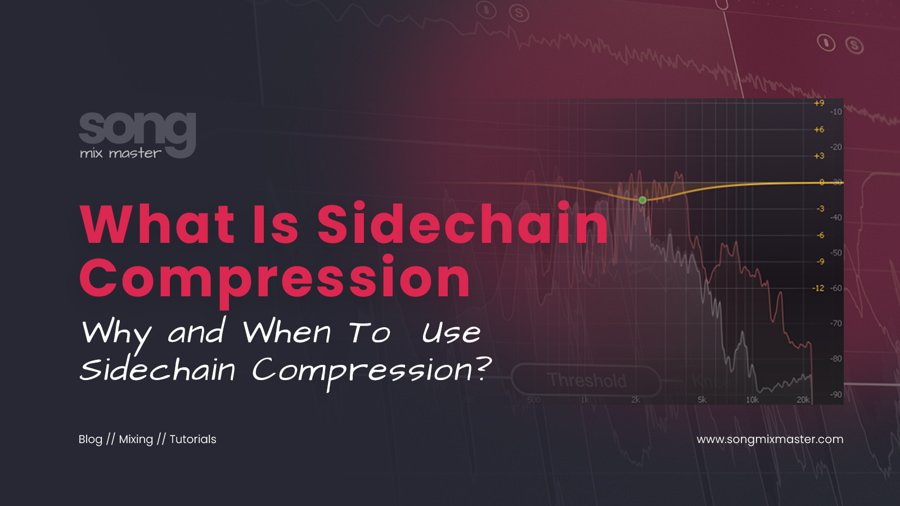Sidechain compression is a powerful audio processing technique that has become a staple in modern music production and audio mixing. It’s used across various genres to create dynamic, polished audio mixes. This guide will cover everything you need to know about sidechain compression, from the basics to the best tools for doing the job.
What is Sidechain Compression?
Sidechain compression is a technique where the compressor’s gain reduction is controlled by an external audio signal (the “sidechain input”) rather than the audio signal it’s processing.
This allows one track (e.g., a kick drum) to dynamically control the volume of another track (e.g., a bassline), creating a pumping effect that can add clarity and movement to a mix.

Why Use Sidechain Compression?
Sidechain compression serves several key purposes:
- Creating Space in the Mix: It helps create space for prominent elements like the kick drum by reducing the volume of other conflicting elements, ensuring they stand out clearly.
- Adding Groove and Movement: It adds rhythmic movement and groove to the music, which is especially popular in genres like EDM and dance music.
- Improving Clarity: It prevents low-frequency elements from clashing, which improves the overall clarity of the mix.
- Dynamic Control: It provides dynamic control over complex mixes, allowing for more precise audio shaping.
Best DAWs for Sidechain Compression
Almost all modern DAWs support sidechain compression, but some make the process easier and more intuitive. Here are a few that excel in this area:
- Ableton Live: Known for its intuitive interface and real-time performance capabilities, Ableton Live makes sidechain compression straightforward with its built-in compressor.
- FL Studio: Offers simple routing options and a user-friendly interface for sidechain compression, making it a favorite among EDM and hip-hop producers.
- Logic Pro X: Provides a comprehensive set of tools and an easy-to-use sidechain feature within its stock compressor.
- Cubase: Known for its powerful audio processing capabilities, Cubase offers detailed control for sidechain compression.
- Studio One: With its drag-and-drop functionality and clear routing, Studio One is another excellent choice for applying sidechain compression.

Best Plugins for Sidechain Compression
While most DAWs come with built-in compressors that support sidechaining, there are several third-party plugins that offer advanced features and high-quality processing:
- FabFilter Pro-C 2: Known for its high-quality sound and versatile features, Pro-C 2 is a favorite for sidechain compression.
- Waves SSL G-Master Buss Compressor: Offers classic SSL compression with easy sidechain functionality, perfect for gluing mixes together.
- Xfer Records LFO Tool: Although primarily an LFO shaping tool, it’s widely used for sidechain-style volume automation in electronic music.
- iZotope Neutron 3: Includes advanced sidechain capabilities within its suite of dynamic processors.
- Kickstart by Nicky Romero: A simple yet effective tool specifically designed for creating the sidechain pumping effect in dance music.
How Hard is it to Learn About Sidechain Compression?
Learning sidechain compression can range from straightforward to moderately complex, depending on your prior experience with audio processing. Grasping the concept of sidechain compression is relatively easy. It involves understanding how one audio signal can trigger compression on another.
Implementing sidechain compression in your DAW requires familiarity with your DAW’s routing and compressor settings. Mastering sidechain compression involves experimenting with attack, release, threshold, and ratio settings to achieve the desired effect.
How to Apply Sidechain Compression
Here’s a step-by-step guide to applying sidechain compression in a typical DAW (using Ableton Live as an example):
- Insert a Compressor: Add a compressor to the track you want to compress (e.g., a bassline).
- Enable Sidechain: In the compressor’s settings, enable the sidechain input.
- Select the Sidechain Source: Choose the track that will trigger the compression (e.g., a kick drum).
- Adjust Compressor Settings: Set the threshold, ratio, attack, and release to shape the compression effect. For a typical pumping effect, use a fast attack and release.
- Fine-Tune: Play the track and adjust the settings until you achieve the desired dynamic effect.
Also, read our FL Studio Sidechain Compression Step-by-step Guide
Conclusion
Sidechain compression is an essential technique in modern music production that can significantly enhance the clarity, dynamics, and overall impact of a mix. Whether you’re just starting out or looking to refine your skills, understanding and mastering sidechain compression is a valuable asset for any producer.
With the right DAW and plugins, and some practice, you can leverage this technique to create professional-sounding tracks that stand out.
For more tips and tutorials on music production, visit our blog at Song Mix Master.


Disclaimer: Any references to any brands on this website/webpage, including reference to products, trademarks, brands and companies, are provided for description purposes only. We don't have any association with or endorsement by these brands or companies. Some of the links on our blog may be affiliate links. This means if you click on these links and make a purchase, we may earn a commission at no extra cost to you.
Need Professional Mixing & Mastering?
You may also like to read...
Mastering Natural Vocals: Essential Tips for Musicians
The True Skill Behind Expert Audio Mixing
Audio Recording – Ensuring a Successful Recording Session
7 Best Value Studio Microphones For Recording Vocals
Analog vs. Digital Mixing: A Sound Engineer’s Perspective
Audio Clipping in Music: Causes, Consequences, and Solutions